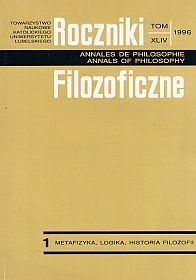The Troubles with Essence. On Some Essential and Non-essential Concepts of "Essence" (with Reference to Rev. Jan Salamucha)
Abstract
The author considers three groups of concepts of essence, defines them in the modified language of functional calculus and classes calculus, points out connections between them, analyses their difficulties and presents the concepts derived from "essence".
These groups are as follows:
1. Three non-essential concepts of "essence" (found in works by Arystoteles, M. A. Krąpiec, T. Czeżowski, A. B. Stępień), i.e.:
(i) essence as any property of the object:
∧ x ∧ I (I is the essence of x ≡ I x);
(ii) essence as the necessary property of the object:
∧ x ∧ I is the essence of x ≡ ∧ y [(x = y) → Iy] ;
(iii) essence as all properties of the object:
∧ x ∧ I I is the essence of x ≡ ∧ P [Px ≡ (P ∈ I) .
2. One more essential concept of "essence" (Rev. J. Salamucha, and also: Arystoteles, St. Thomas Aquinas, K. Ajdukiewicz, A. B. Stępień), i.e. essence as the property «common» to all object of the given group (and only to these objects):
∧ x ∧ I I is the essence of x as Z ≡ [(x ∈ Z) →/← Ix] .
3. Two the most essential concepts of "essence" (K. Ajdukiewicz, T. Kotarbiński), i.e.:
(i) the simple essence as a «common» and «characteristic» property (see 2.), from which the other important («characteristic») properties result:
∧ x ∧ I ∧ Z ⟨I is the simple essence of x as Z ≡ [(x ∈ Z ≡ Ix] ∧ y ∧ PW [y ∈ Z) → Pwy] → (Iy → PWy) ⟩;
(ii) the complex essence as the constitutive intension of a name:
∧ x ∧ I ∧ Z ∧ P ∧ Q ⟨I is the complex essence of x as Z ≡ [(x ∈ Z) ≡ Ix] ∼ ∨ P ∧ Q {[Q = (I − P)] → ∧ y [(y ∈ Z ≡ Qy] ⟩.
Copyright (c) 1996 Roczniki Filozoficzne

This work is licensed under a Creative Commons Attribution-NonCommercial-NoDerivatives 4.0 International License.





